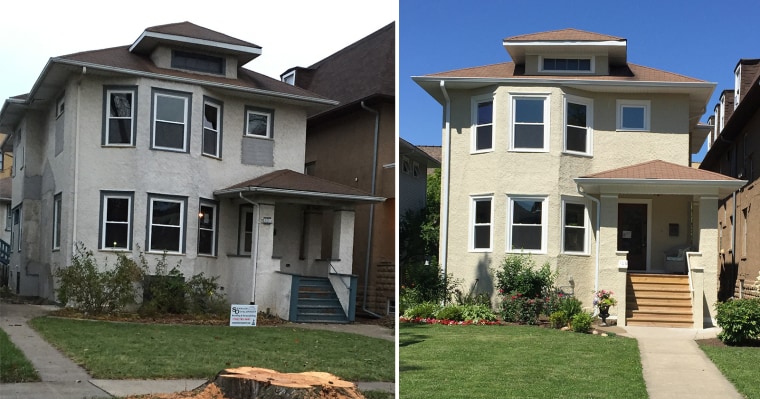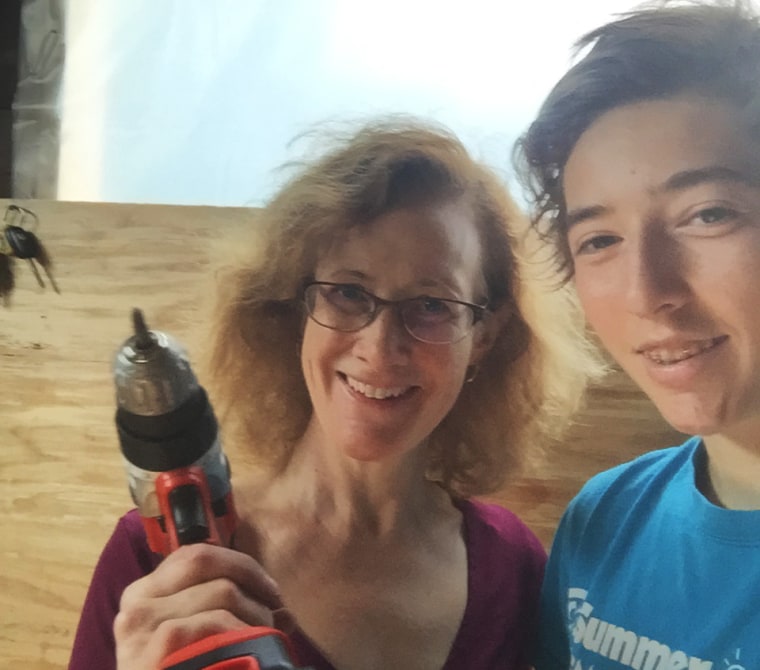Television shows like HGTV's "Masters of Flip” and “Flip or Flop” make house flipping look simple: You buy a run-down home, make some upgrades and sell it at a profit.
But it’s actually more complicated, according to those who’ve tried.
Beth Franken made renovations 17 years ago to her Oak Park, Illinois, home, doubling its value over four years. “I thought if it worked for us, why not try a flip? It seems like something a lot of people have fantasies about, like acting or dancing,” Franken, 60, told Know Your Value.
And that’s what Franken, a former professional writer and now a realtor, did. She purchased a run-down home in her neighborhood, made $325,000 worth of renovations and eventually walked away with a $60,000 profit. But it wasn’t without several trials and tribulations, including the discovery of a sanitary pipe in the front foyer instead of inside the wall, a floor repairman not showing up, failing the first insulation inspection and purchasing windows and fixtures that wouldn’t fit.

As Franken figured out, flipping a house is no cakewalk, which may be why fewer people are flipping these days. In the third quarter of 2018, 45,901 single-family homes and condos were flipped in the U.S., a 12 percent decrease from a year ago, according to real-estate data firm Attom Data Solutions. That number is the lowest since the first quarter of 2015.
Why the decline? For one, people who invest in homes with the intention of fixing them up and selling are making less money on the homes they are flipping, raking in a gross profit of $65,520, versus $69,000 a year ago, according to Attom Data Solutions. That number leaves out what the buyer spent on repairs and costs associated with buying and selling, which can add $30,000 to $50,000 or more.
In short, a large profit margin is no guarantee.
Making it Work
Home prices in Oak Park, a village nine miles outside of Chicago, where Franken lives, are relatively healthy. “People buy here to be close to the city and have a backyard,” Franken said.
She became particularly interested in flipping in her neighborhood when a house on her street sold 30 percent under market value to an investor. So she teamed with local real estate agent Linda Rooney and eventually bid on a short-sale home near the village’s center in 2016.
The property had seen better days. After all, the previous family had owned it for six decades. Windows were cracked, the porch stairs sagged, a sloppy, overgrown forsythia screened the bottom half of the first-floor windows — and that was just the outside. Inside, the home would have required a substantial investment to turn into a rental property.
So, Franken, a single mom with two teenage sons, thought a single-family home in that location would be worth more, selling for about $780,000. If she could pay less than $300,000, spend an estimated $260,000 in renovations and $40,000 in loan carrying costs, she might make about $150,000 (factoring in closing costs).
“Unfortunately, a house that’s flippable is like a twenty dollar bill on the sidewalk; it’s not there for long,” she said. The sellers initially declined her $274,000 bid, but reconnected three months later and accepted.
Now for the hard part
Franken was her own general contractor and hired a sub-general (who brought in tradesmen) and a husband-and-wife architect team. She used a home equity line of credit and dipped heavily into her retirement account. Repairs ultimately cost $325,000, a whopping 25 percent over her budget.
“The final touches were the hardest,” said Franken. For example, the workmen were impatient to move to their next job and were reluctant to spend time tweaking baseboards and adding finger-pulls to sliding closet doors.

She also spent 15 to 20 hours a week managing the flip, with some weeks requiring more attention than others. As a final step, she staged the home with items from her own house and some borrowed from a local furniture store.
The house, which started out as two separate living spaces, had to be completely gutted to build the single-family home. Franken planned for a sizeable kitchen, dining room, family room, full bath and a spare bedroom/office downstairs. Upstairs, she built four bedrooms, a walk-in storage closet with barn door, a huge laundry room and two full baths.
Patience with the waiting game
Her flip listed in May 2017 for $828,800. She got an above-list offer before she even had the open house. “However, after 10 days later, that contract fell apart, and when we went back on the market there was no activity at all," she said, adding that she dropped the price to $799,000.
A low-ball offer came in July, but Franken was unable to come to terms with that buyer. Finally, in August, the house sold for $775,800, just five days before the Franken’s one-year anniversary of buying it.
The price was “almost exactly” what she’d hoped for. “However, I went easily $60,000 over budget, and it took three months longer to sell than I imagined,” said Franken, who paid $55,000 in carrying costs. “So what should've been a killing turned out to be just a nice profit, around 21 percent on the investment. But it could have and completely ruined me if it hadn’t sold when it did.”
“All of my home equity and a huge chunk of my 401K had been spent, and I needed to get that money back,” she explained.
Not for the faint of heart
For women in particular, the “fear of losing it all” prevents them from taking on a home-flipping project in comparison to men, said Debbie DeBerry, a Texas realtor who is nicknamed “The Flipstress.”
Although still a male-dominated field, real estate investing is attracting women like Franken who want to generate income during retirement.
“What many women don’t realize is that there are many, many ways to reduce your risk throughout the entire flip project, from the financing source, to choosing the right property in the right neighborhood and renovating it the right way, per the market data,” DeBerry told Know Your Value.
In the end for Franken, it was worth it. She became a realtor in 2018 and made an offer on a new house to flip this spring. “There is a certain sense of adventure that’s compelling,” she said. “Having done one flip, I have a better idea of what to expect.”
What to consider before you try a flip
Before you try your hand at flipping, there are a few things to consider.
1. Research your market and buyers
Flippers should follow area listings for months to understand if home values are going up, down, or holding steady. You should also have a sense of how long homes typically stay on the market, said DeBerry, who’s been involved in hundreds of house flips and mentors women interested in taking on such projects.
DeBerry targets properties in specific neighborhoods with an after-repair value of $375,000 to $475,000 that will yield at least a 15 percent profit. She also looks at who’s buying and what they want in terms of home size and amenities. “The secret to flipping houses successfully is to give buyers exactly what they want, where they want it. The market data tells you all of this,” said DeBerry.
2. Buffer expenses
Be disciplined with your numbers, advised Franken. Her brother, an actuary, helped her calculate interest and closing costs, and encouraged her to track every possible expense on an Excel spreadsheet, including those she had been tempted to brush aside — like utility bills. Then add a 20 percent buffer to those figures for the “unexpected,” which in Franken’s case happened when the electrician knocked out the walls and discovered there was no insulation, adding another $6,000 to expenses.
3. Get professional help
If you’re not a realtor or contractor, use a pro you’ve vetted and are comfortable with to manage your first flips, said DeBerry. While this typically adds 10 to 15 percent to your project cost, it can pay off by keeping your project on time and well managed. “The point is to have a successful first flip so you’ll want to continue flipping,” added DeBerry.
4. Brace for the unexpected
Distressed properties, while attractive to flippers, can carry emotional baggage. For example, Franken was physically threatened by the seller's daughter after closing on the flip. “These are parts you don’t foresee … Flipping isn’t just about the black splash and paint color. It’s dealing with someone’s wrecked life. It’s sorting through the stuff they’ve had to leave behind.”
